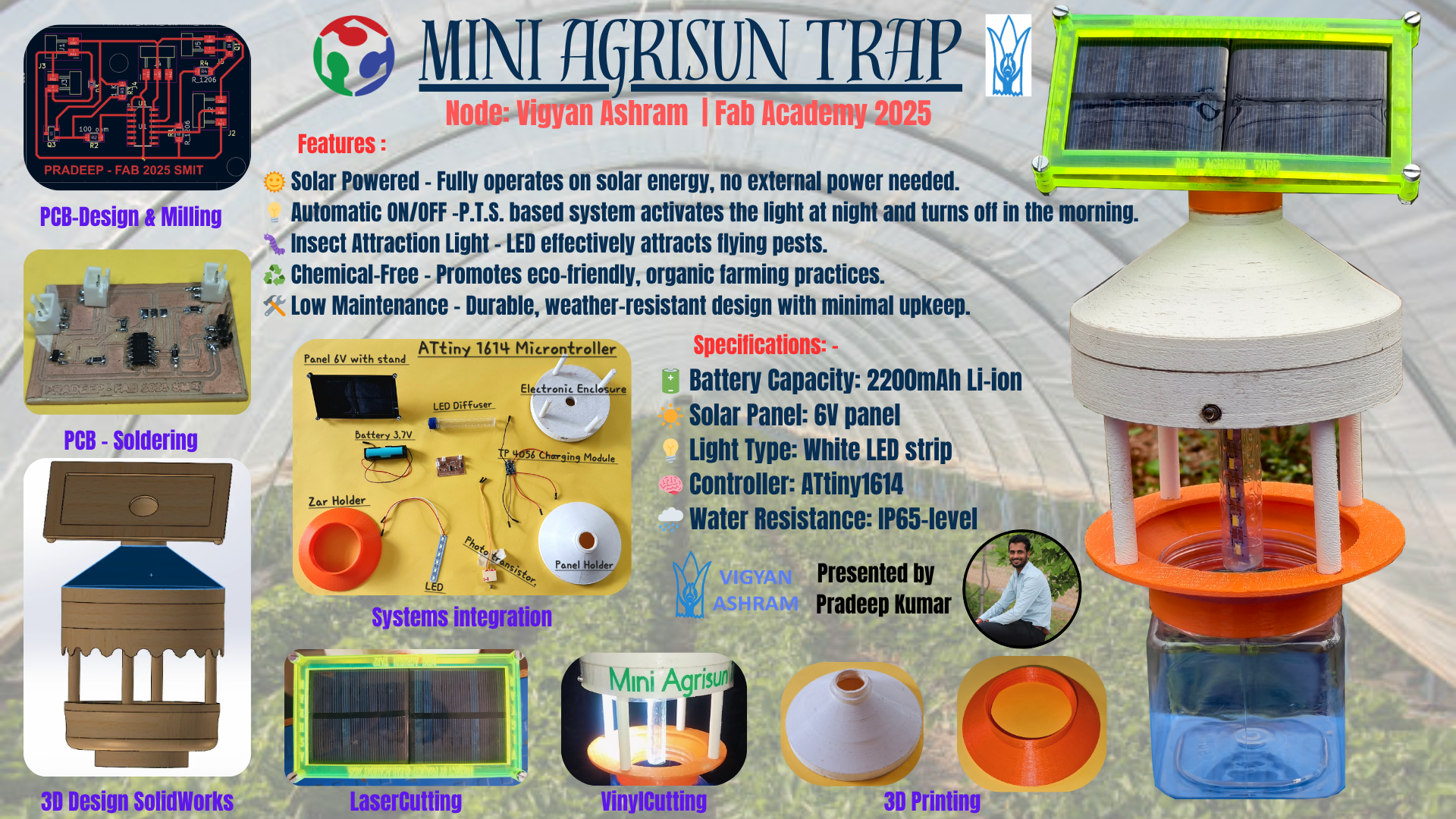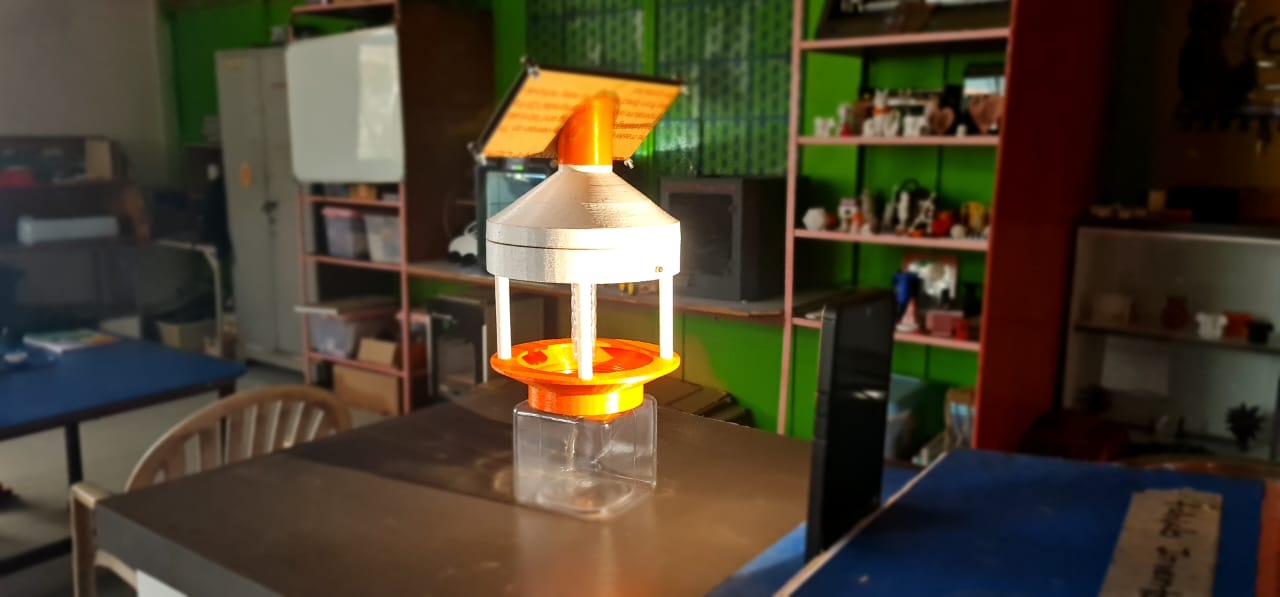1. Target Audience Identification
Primary Audience: The Mini AgriSun Trap is specifically designed to serve small and marginal farmers in rural and semi-rural areas, offering them an affordable, sustainable, and effective pest control solution that enhances crop protection while minimizing environmental impact.
Secondary Audience: Key stakeholders such as agriculture extension officers, NGOs, and Krishi Vigyan Kendras (KVKs) play a vital role in promoting the trap's adoption by providing technical guidance, raising awareness, and supporting farmers throughout the implementation process.
Tertiary Audience: Educational institutions specializing in agriculture, Fab Labs, and innovation hubs contribute significantly by encouraging research, innovation, and hands-on training, thus advancing the development and dissemination of eco-friendly farming technologies like the Mini AgriSun Trap.
2. Product Launch and Marketing Strategy
- Website Integration: Showcase the Mini AgriSun Trap comprehensively on your Fab Academy project page by providing detailed documentation, high-quality images, downloadable user manuals, and step-by-step tutorial videos, ensuring that users can easily understand and effectively utilize the product.
- Social Media Campaign: Leverage platforms such as Facebook, Instagram, and YouTube to share authentic field testing footage, time-lapse videos of insect trapping, and genuine testimonials from farmers, thereby creating strong awareness and building trust among the target audience.
- Participation in Farmer Melas and Agricultural Exhibitions: Actively present the Mini AgriSun Trap at rural development fairs and agricultural expos like Krishi Mela to directly demonstrate its practical benefits to farmers, agricultural experts, and stakeholders.
- Collaboration with Agricultural Departments: Establish pilot programs in partnership with state agricultural departments to implement and evaluate the Mini AgriSun Trap at the field level, facilitating large-scale adoption based on real-world performance.
3. Pilot Programs and Feedback Collection
- Field Trials: Carefully selected farmers will receive Mini AgriSun Trap units to implement in their fields, allowing us to closely monitor and analyze the effectiveness of the traps in reducing harmful insect populations and improving overall crop health in real agricultural conditions.
- Farmer Feedback: We will actively gather detailed feedback through both printed questionnaires and video interviews, providing farmers an accessible platform to share their experiences, suggestions, and any challenges they face, enabling us to refine and enhance the trap design based on real user insights.
- Live Demonstrations: Interactive demonstration camps will be organized in collaboration with local Krishi Vigyan Kendras (KVKs), offering farmers hands-on exposure to the Mini AgriSun Trap’s operation and benefits, while also fostering community engagement and trust in this innovative pest management solution.
4. Distribution Channels
- Online Marketplaces: Utilize prominent e-commerce platforms such as Amazon, Krishify, and DeHaat, along with a dedicated online store, to ensure wide accessibility and convenient purchasing options for farmers across diverse regions.
- Local Retail Partnerships: Establish strong collaborations with local agricultural input dealers and cooperative societies to create trusted physical points of sale, enabling farmers to access the Mini AgriSun Trap directly within their communities.
- NGO Collaborations: Work closely with non-governmental organizations committed to promoting sustainable agriculture, facilitating subsidized or free distribution programs that empower small and marginal farmers to adopt eco-friendly pest management solutions.
5. Support and Community Building
- Interactive WhatsApp and Social Media Groups: Establish dedicated WhatsApp and Facebook communities where farmers can easily connect to share experiences, seek advice, and troubleshoot any challenges related to the Mini AgriSun Trap, fostering peer-to-peer learning and mutual support.
- Multilingual Video Tutorials: Develop comprehensive, easy-to-follow video guides in regional languages such as Hindi, Rajasthani, and Marathi, ensuring that farmers from diverse linguistic backgrounds can fully understand and efficiently operate the trap for maximum benefit.
- Empowering Farmer Leaders: Identify and collaborate with enthusiastic early adopters who can act as local champions, offering hands-on training to their peers and helping to expand the adoption of the Mini AgriSun Trap within their communities.
6. Educational Content and Curriculum Integration
- Comprehensive Training Modules: Design and implement detailed educational modules tailored for Industrial Training Institutes (ITIs), agricultural diploma courses, and Fab Labs, focusing on the practical application and maintenance of the Mini AgriSun Trap to empower the next generation of sustainable farming innovators.
- Encouraging Student Innovation: Motivate final-year students specializing in agriculture, horticulture, and related fields to engage with the Mini AgriSun Trap as part of their capstone projects, promoting hands-on learning and encouraging improvements or adaptations that suit local pest management needs.
- Collaborative Hackathons and Competitions: Organize innovation challenges and hackathons that invite participants to creatively enhance the trap’s functionality, such as integrating smart IoT capabilities or improving energy efficiency, thereby fostering a culture of continuous improvement and technological advancement in agricultural pest control.
7. Impact Assessment and Iteration
-
Comprehensive surveys will be conducted regularly to gather precise data on the reduction of harmful insect populations, the consequent decrease in chemical pesticide usage, and the resulting improvements in crop yield and quality, thereby validating the effectiveness of the Mini AgriSun Trap in diverse farming conditions.
-
Detailed annual performance reports will be compiled and shared with key stakeholders, including farmers, agricultural departments, and funding agencies, to transparently communicate progress, challenges, and measurable outcomes, fostering trust and encouraging wider adoption.
-
Continuous innovation will be prioritized by integrating feedback from users and field data to develop upgraded versions of the trap, which may feature advanced technologies such as GSM-based alerts, real-time insect counting sensors, and seamless mobile app connectivity for smarter pest management solutions.
Creative Commons Licensing Process for Mini AgriSun Trap
In order to appropriately license my final project and protect both the originality and integrity of my work, I began by visiting the official Creative Commons license chooser tool available at https://creativecommons.org/chooser/.

Once the website loaded, I clicked on the “Choose a License” button, which redirected me to the interactive license chooser interface titled "Get Started with the Chooser." This intuitive tool guides users through a series of questions to determine the most suitable license based on their preferences and intended use.

Since I was unfamiliar with the detailed implications of each option, I carefully studied each question presented—seven in total—and thoughtfully selected the appropriate responses. These questions covered aspects like attribution, commercial usage, and permissions for derivative works. After I completed the form, a final result page appeared, displaying the most appropriate license for my project.


Based on my selections, the website recommended the CC BY-NC-ND 4.0 license. This license stands for Creative Commons Attribution-NonCommercial-NoDerivatives 4.0 International, which permits others to share my work with proper credit but prohibits commercial use and modifications.

Along with the license details, the site generated a licensing message customized for my project. It stated: “Mini AgriSun Trap © 2025 by Pradeep Kumar is licensed under CC BY-NC-ND 4.0 Creative Commons Attribution Non-Commercial No Derivatives.”

The website also provided a ready-to-use HTML snippet containing the license text, linked to the full license terms, and including visual license icons. I copied this HTML code for integration into my Fab Academy website.

Finally, I inserted the HTML license code into the footer section of my final project webpage. This ensures that anyone who visits my site can clearly see the licensing terms under which my project has been shared.


Final Product slide
Final Product Video
Future Possibilities for Mini AgriSun Trap
-
IoT-Enabled Monitoring: By integrating advanced GSM or Wi-Fi communication modules into the Mini AgriSun Trap, farmers and researchers can remotely monitor insect activity patterns in real-time, enabling precise pest management decisions without the need for constant physical inspection. This connectivity not only facilitates timely interventions but also contributes to data-driven agricultural practices that enhance crop health and yield.
-
Smart Auto-Switching Mechanism: Implementing sophisticated day and night sensors will allow the trap to automatically activate at dusk and deactivate at dawn, optimizing energy consumption and maximizing insect capture efficiency. This smart feature ensures the device operates only during peak insect activity periods, reducing unnecessary power use and extending the lifespan of the solar-powered system.
-
Community Solar Hubs for Large-Scale Farming: The concept of connecting multiple Mini AgriSun Traps into a centralized network powered by community-based solar energy hubs opens new avenues for sustainable pest control on large farms. This collaborative solar infrastructure can provide continuous, reliable energy, enabling extensive coverage while promoting renewable energy use and reducing dependency on conventional power sources.
-
Insect Recognition Using Artificial Intelligence: Integrating a compact camera system with an embedded AI model can revolutionize the Mini AgriSun Trap by enabling automatic identification and classification of trapped insects. This intelligent feature empowers farmers with detailed pest analytics, helping them to understand pest populations better and tailor their crop protection strategies accordingly.
-
Bio-Composting Chamber for Sustainable Fertilizer Production: An innovative addition of a bio-composting compartment within the trap can transform captured insects into valuable organic fertilizer. This eco-friendly upgrade not only promotes waste recycling but also supports circular farming practices by converting pest biomass into nutrient-rich compost, contributing to soil health and sustainable agriculture.

